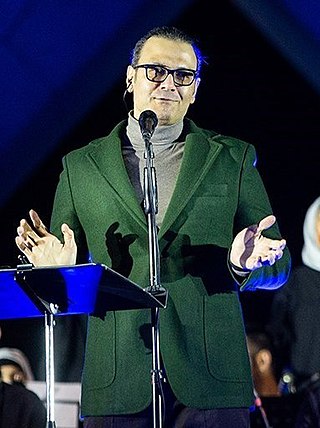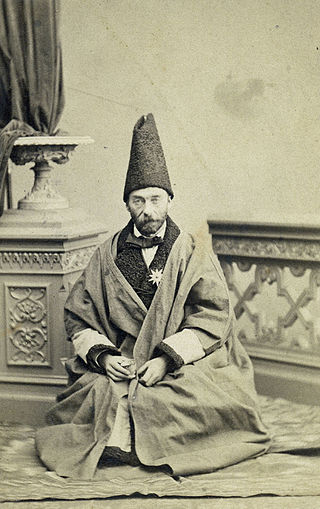The music of Iran encompasses music that is produced by Iranian artists. In addition to the traditional folk and classical genres, it also includes pop and internationally celebrated styles such as jazz, rock, and hip hop.

Mohammad Ali Shah Qajar, Shah of Iran from 8 January 1907 to 16 July 1909. He was the sixth shah of the Qajar dynasty.

Fath-Ali Shah Qajar was the second Shah (king) of Qajar Iran. He reigned from 17 June 1797 until his death on 24 October 1834. His reign saw the irrevocable ceding of Iran's northern territories in the Caucasus, comprising what is nowadays Georgia, Dagestan, Azerbaijan, and Armenia, to the Russian Empire following the Russo-Persian Wars of 1804–1813 and 1826–1828 and the resulting treaties of Gulistan and Turkmenchay. Historian Joseph M. Upton says that he "is famous among Iranians for three things: his exceptionally long beard, his wasp-like waist, and his progeny."
Iranian philosophy or Persian philosophy can be traced back as far as to Old Iranian philosophical traditions and thoughts which originated in ancient Indo-Iranian roots and were considerably influenced by Zarathustra's teachings. According to the Oxford Dictionary of Philosophy, the chronology of the subject and science of philosophy starts with the Indo-Iranians, dating this event to 1500 BC. The Oxford dictionary also states, "Zarathustra's philosophy entered to influence Western tradition through Judaism, and therefore on Middle Platonism."
André Hossein, born Aminulla Huseynov, also known as Aminollah Hossein was a French composer Iranian Azerbaijani origin and a tar soloist. Hossein was the first Persian composer who was able to present his works in international concerts.

Prince Firouz Nosrat-ed-Dowleh III, GCMG (1889–1937) was the eldest son of Prince Abdol-Hossein Farmanfarma and Princess Ezzat-ed-Dowleh Qajar. He was born in 1889 and died in April 1937. He was the grandson of his namesake, Nosrat Dowleh Firouz Mirza, and of Mozzafar-al-Din Shah Qajar through his mother, Princess Ezzat-Dowleh.
Symphonic music in Iran encompasses Iranian musical pieces composed in the symphonic style. In addition to instrumental compositions, some of Iran's symphonic pieces are based on the country's folk songs, and some are based on poetry of both classical and contemporary Iranian poets.

Hossein Dehlavi was an Iranian composer.

Heshmat Sanjari, also transcribed as Sandjari was a well-known Persian (Iranian) conductor and composer, the son of Hossein Sanjari who was well-known player on tar in Persia.
Persian calligraphy or Iranian calligraphy is the calligraphy of the Persian language. It is one of the most revered arts throughout the history of Iran.

Alireza Ghorbani is an Iranian traditional vocalist.

The Tehran Symphony Orchestra, founded in 1933, is Iran's oldest and largest symphony orchestra. It was founded as the Municipality Symphony Orchestra by Gholamhossein Minbashian, before entering its modern form under Parviz Mahmoud in 1946. In the years that followed, conductors such as Rubik (Ruben) Gregorian, Morteza Hannaneh, Haymo Taeuber, Heshmat Sanjari, and Farhad Meshkat took over as the conductors of the orchestra.

The Islamic Republic of Iran Volleyball Federation(I.R.I.V.F.) is the governing body for Volleyball in Iran. It was founded in 1945, and has been a member of FIVB. It was a part of Iranian Basketball Federation till 1957. It is also a member of the Asian Volleyball Confederation. The IRIVF is responsible for organizing the Iran men's national volleyball team and Iran women's national volleyball team.

Amir Houshang Ostovar was a Persian symphonic music composer and Instructor.

Jakob Eduard Polak was an Austrian physician, born to a Jewish family from Bohemia, who played an important role in introducing modern medicine in Iran.

Ali (Alexander) Rahbari is an Iranian composer and conductor, who has worked with more than 120 European orchestras, including the Berlin Philharmonic and the Mariinsky Opera.
The following is a timeline of the history of the city of Tehran, Iran.

Seyyed Mohammad Motamedi is an Iranian traditional vocalist, and a ney player.

Hossein Ali Beg Bayat was a Safavid diplomat from the Turkoman Bayat clan, who served as the ambassador to the Holy Roman Empire, the Russian Tsardom, Habsburg Spain and several other royal and noble courts during the reign of king Abbas I, and was part of the first Safavid embassy to Europe.













